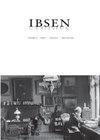Reimagining Ibsen’s Women in Will Eno’s Gnit: Language and the Everyday
IF 0.1
0 THEATER
引用次数: 0
Abstract
The sepia photograph on the cover of the American edition of Will Eno’s Gnit (2013) shows a cowboy walking away from the viewer, a suitcase in one hand and a long, coiled length of rope in the other. This iconic silhouette is leaving us, heading down a muddy path into an overcast rural landscape. The image conjures up mythic and forlorn thoughts of the frontier, the freedom and loss of the unattached drifter, and the emotionally bruised or stunted American male of so many depictions. It is a fitting image for what the back cover describes as Eno’s “faithful, unfaithful, and willfully American misreading” of Henrik Ibsen’s sprawling 1867 drama, Peer Gynt. This “misreading” of Peer Gynt is both a flippant exercise in condensation and a morally serious homage. Gnit is an extremely funny play, as Eno is the playwright who inspired the term “stand-up existentialism,” but it is also a mournful look at loneliness, regret, and the difficulties of language and human connection. Eno’s version maintains an earnest ethical purpose with regard to a central theme in Peer Gynt: that the self is realized not in an abstract search for autonomy or authenticity, but in concrete relations and commitments to others. Peter Gnit evades responsibility, love, and community in search of a grandiose, but fatuous notion of self-discovery. Like Ibsen’s Peer Gynt, Peter Gnit takes a detour through life, following his erotic whims and hunger for greatness around the world,在威尔·伊诺的《Gnit》中重新想象易卜生的女性:语言与日常
威尔·伊诺(Will Eno)的《Gnit》(2013)美国版的封面上有一张棕褐色的照片,照片中,一个牛仔从观众身边走开,一只手拿着手提箱,另一只手拿着一根长长的卷绳。这个标志性的剪影正离开我们,沿着泥泞的小路进入阴暗的乡村景观。这一形象让人联想到神话和荒凉的边疆,自由和失去的单身漂流者,以及情感上受伤或发育不良的美国男性的许多描绘。这本书的封底描述伊诺对亨里克·易卜生(Henrik Ibsen) 1867年的巨著《佩尔·金特》(Peer Gynt)“忠实、不忠实、故意的美式误读”,这是一个合适的形象。这种对培尔·金特的“误读”既是一种轻率的浓缩,也是一种道德上严肃的致敬。《Gnit》是一部非常有趣的戏剧,因为伊诺是“单口相声存在主义”一词的创造者,但它也以悲伤的方式审视了孤独、遗憾、语言和人际关系的困难。伊诺的版本保持了一种关于培尔金特中心主题的严肃的伦理目的:自我不是在对自治或真实性的抽象追求中实现的,而是在对他人的具体关系和承诺中实现的。彼得·格尼特逃避责任、爱和社区,寻找一种浮夸但愚蠢的自我发现概念。就像易卜生的《培尔·金特》一样,彼得·格尼特在人生中走了一条弯路,跟随他的性冲动和对世界伟大的渴望,
本文章由计算机程序翻译,如有差异,请以英文原文为准。
求助全文
约1分钟内获得全文
求助全文

 求助内容:
求助内容: 应助结果提醒方式:
应助结果提醒方式:


